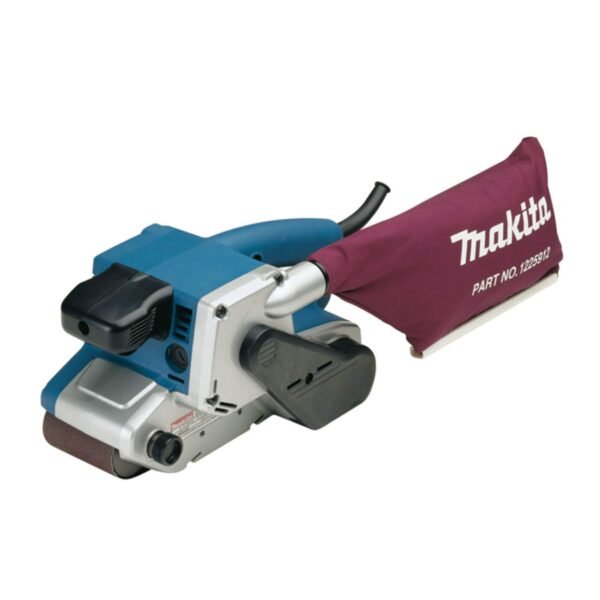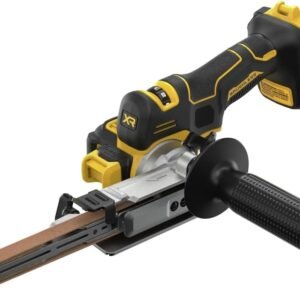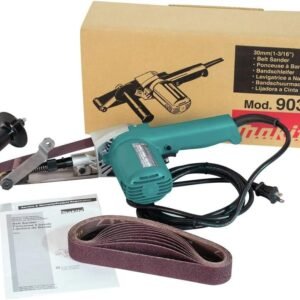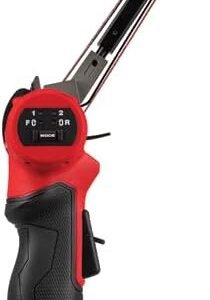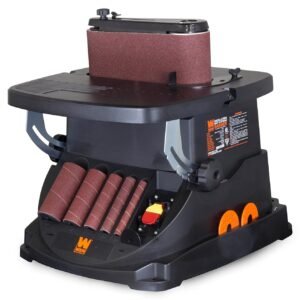In-Depth Review of Makita 9903 Belt Sander Best Corded Power Tool for Woodworkers
In-Depth Review of Makita 9903 Belt Sander Best Corded Power Tool for Woodworkers
- Powerful 8.8 AMP motor delivers consistent performance even under heavy load.
- The auto-tracking belt system eliminates the need for manual adjustments, saving time and frustration.
- Designed to sand flush to walls effortlessly, thanks to its innovative low-profile and extended base.
- Comfort is enhanced by the front grip, making extended use much easier on the hands.
As an Amazon Associate I earn from qualifying purchases.
Description
Highlights of Power and Precision in Sanding
Testing the Makita 9903 3″ x 21″ Belt Sander brought a clear appreciation for its powerful 8.8 AMP motor. This sander doesn’t just hum along; it delivers consistent, robust stock removal that can handle tough woodworking projects without bogging down. The variable speed control dial impressed me, allowing me to adjust speed anywhere between 690 and 1,440 feet per minute, which is crucial for matching the sanding pace to different materials and finishes. The auto-tracking belt system also deserves praise—it maintains belt alignment seamlessly without requiring manual adjustments, saving me frustration and downtime.
The sander’s ability to sand flush to walls thanks to its innovative nose and side design was a game changer in tight spots where other models faltered. Plus, the front grip made it comfortable to maneuver for extended periods, reducing hand fatigue significantly. The relatively quiet operation at 85 decibels was a pleasant surprise, especially compared to louder belt sanders that can be ear-splitting on job sites.
Drawbacks That Are Worth Considering
While I found many features beneficial, some limitations surfaced during use. The weight of 9.5 pounds made it a bit cumbersome for prolonged overhead or vertical sanding tasks; holding it steady for long periods required extra effort. The dust bag, although included, seemed somewhat small and tended to fill quickly, which meant frequent emptying to keep the work area neat. Also, the plastic housing, while durable, felt less rugged compared to some metal-bodied competitors, raising concerns about long-term durability under heavy job site abuse.
Another minor gripe was the power cord length of 16.4 feet. Although decent, I occasionally wished for a longer cord when working in larger spaces without readily accessible outlets. This isn’t a dealbreaker but something to keep in mind depending on your workspace layout.
Versatile Features for Woodworkers and Contractors
This belt sander is clearly aimed at professionals and serious hobbyists alike. Its electronic speed control ensures the motor maintains constant speed even under load, which is critical for achieving smooth, uniform sanding results. I tested it on various wood surfaces—cabinets, furniture panels, and even closet doors—and it performed admirably across these tasks. The extended base design allowed me to sand edges and corners with precision, enhancing the quality of finish without extra effort.
The inclusion of an abrasive #80 belt out of the box was handy, although I quickly swapped it for finer grits depending on the project. The availability of an optional sanding shoe provides additional control over sanding depth, an excellent upgrade for detail work. The double insulation adds a safety layer, reducing electrical shock risks, which made me feel more confident during extended use.
Price Performance That Matches Quality
Evaluating the sander’s price to quality ratio, it strikes a balance that feels justified for its feature set and build. While there are cheaper belt sanders on the market, few offer the combination of variable speed, quiet operation, and auto-tracking belts at this level. It’s not the most budget-friendly option if you’re a casual user, but for craftsmen who value precision and durability, it represents smart spending.
Given its capabilities, the sander seems worth every penny for those who frequently tackle woodworking or flooring projects. It also holds up well for deck builders and contractors needing a reliable tool for heavy-duty sanding. The long power cord and comfortable grips contribute to productivity, minimizing interruptions and discomfort during work.
Competitive Options and How This Sander Stands Out
Comparing this belt sander to other popular models like the Porter-Cable 362V or the Bosch PBS75-20 reveals some interesting contrasts. The Makita’s lower noise level and better speed control range give it an edge for indoor and precision work. The Porter-Cable, while powerful, tends to be louder and lacks the smooth auto-tracking system, which can lead to more frequent belt adjustments. Bosch offers similar ergonomics but slightly less power and a shorter cord, which might limit workspace freedom.
That said, some competitors feature more rugged metal bodies, which could appeal to those seeking maximum durability on rough job sites. However, the Makita’s innovative design to sand flush against walls is a standout feature that many rivals don’t offer. This makes it particularly useful for cabinetry and trim work where tight corners matter.
User Experience Beyond My Own
My brother, a carpenter, also tried the sander and immediately noted its comfortable grip and stable handling. His experience echoes mine about the weight being a bit heavy but manageable for most tasks. My partner, who’s more into DIY home projects, found the dust collection system helpful but wished the bag was larger to avoid constant emptying during larger sanding jobs.
Interestingly, a coworker appreciated the quiet operation during indoor projects, saying it made a noticeable difference when working in apartments or noise-sensitive environments. These shared experiences reinforce that the sander suits a range of users—from professionals to home enthusiasts—with some caveats on ergonomics.
Good Aspects That Make This Tool a Winner
- Powerful 8.8 AMP motor delivers consistent stock removal
- Variable speed control lets you tailor sanding speed perfectly
- Auto-tracking belt system eliminates manual belt adjustments
- Quiet operation at 85dB reduces noise fatigue
- Design allows sanding flush to walls and corners for precision work
Areas of Concern to Keep in Mind
- Heavier weight (9.5 pounds) can cause fatigue during prolonged use
- Dust bag capacity is limited, requiring frequent emptying
- Plastic housing feels less durable compared to metal alternatives
- Power cord length may be insufficient for larger job sites
Testing this belt sander revealed a machine packed with thoughtful design and professional features, but with a few trade-offs typical for cordless electric tools in this category. Its performance on various surfaces and ease of use make it a reliable choice, especially for those prioritizing quiet operation and precise control in their sanding work.
Additional information
| Brand | Makita |
|---|---|
| Grit Type | Medium |
| Voltage | 110 Volts |
| Power Source | Corded Electric |
| AC Adapter Current | 8.8 Amps |
| Grit Number | 80 |
| UPC | 088381032674 |
| Global Trade Identification Number | 00088381032674 |
| Manufacturer | Makita |
| Part Number | 9903/2 |
| Item Weight | 9.5 pounds |
| Product Dimensions | 11.63 x 5.63 x 6.19 inches |
| Item model number | 9903 |
| Is Discontinued By Manufacturer | No |
| Size | 3" x 21" (76 x 533 mm) |
| Color | Teal |
| Style | Belt Sander |
| Material | Plastic |
| Wattage | 1010 watts |
| Item Package Quantity | 1 |
| Number Of Pieces | 1 |
| Included Components | Belt Sander, 1 Belt, Dust Bag |
| Batteries Included | No |
| Batteries Required | No |
| Warranty Description | 1 Year |
| Date First Available | April 1, 2004 |
